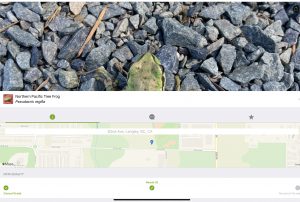As part of my course, LLED 469: Inquiry based Pedagogy in School library Programs, I was invited to choose an option to explore inquiry and document the process. I was immediately drawn to the Place-based Learning option, which in this case was to try out the iNaturalist app from the Apple apps store https://apps.apple.com/ca/app/inaturalist/id421397028
I wanted to try using the app with my seven year old son, Vasco. He is very keen on all things nature. So we packed up our dog and our iPad and headed to one of our favourite creeks near our home. I wanted him to lead the inquiry with questions and ideas. I thought he could be my “Guinea Pig” to see if this app was suitable for kids. (The age on the apps page says its for anyone ages 4 and up).

Questions……..
Some of the questions that came up for us were: What Native peoples live/lived by this creek? Then we snapped a few pictures of some plants we wondered about. What are the plant names? Are they indigenous to BC? Are any of them poisonous? Are any of them edible? Do any of them have medicinal purposes? We also found a frog (which we first thought was a toad) we wanted to identify its species. There were probably more questions but we edited them and decided to try and answer these before adding to our list.

We knew this was a Fern but were unsure which kind

Unknown flower
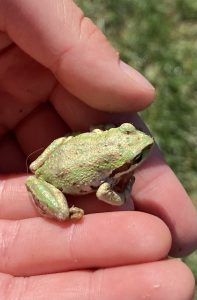
Frog we found
Where to find our answers…..
Besides the zoo iNaturalist, I wanted to find some books and other resources to help us in our inquiry. I personally own the book, and planned on using it to help us find some answers. This book is fabulous but definitely geared more towards adults and maybe teens.
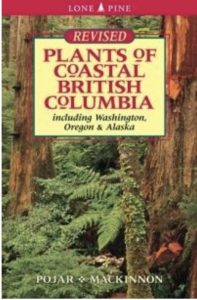
Another Fabulous book that we own and consulted was, “Curious Kids Nature Guide” by Fiona Cohen. It is all about the Pacific North West and geared towards children.
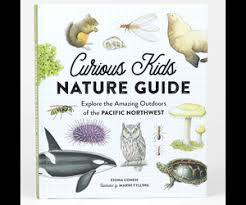
So What did we do find out……?
We were so excited to find what we initially thought was a toad so we decided to start there. We simply uploaded the picture to the iNaturtalist app and BOOM! Our Toad was actually a Northern Pacific Tree Frog. The process was so easy my son could do this on his own after I had shown him how. All of the information was at our fingertips. The app tags the photo to let other users know where the creature/plant was found and also allows others to comment. My son said he felt like a “real” scientist.
Next we had to identify the fern we had found. I wanted to challenge Vasco so I had him try and find the image in the Curious Kids book first. He was able to find it fairly quickly and identified it as a “Lady Fern”. We then uploaded the picture to the app to verify our find. We were right, Lady Fern indeed! Our book nor the app stated whether or not this plant was edible so we then searched for it in the Plants of Coastal British Columbia Book. It told us that these ferns were used by indigenous peoples for laying out or covering food, especially berries for drying. Also they were eaten in spring usually boiled, baked, raw or with grease. We did a quick google search and typed in “lady Fern Medicine” and found a website, http://www.naturalmedicinalherbs.net/ we discovered they were/are used for cancer of the womb, body pains and to induce milk flow for mothers.

Lastly we needed to identify a flower we saw. My son really felt like it might be poisonous because of the bright purple colour. We tried looking in a book first but were unsuccessful. So we uploaded the image to the app and found it right away. It was identifies as “Bittersweet Nightshade”. my son said the name sounded suspicious. We looked in his book first but could not find anything so we turned to the Plants of Coastal British Columbia Book. We found out that this plant is indeed poisonous, although only mildly to my son’s disappointment. It is NOT indigenous to BC but to Europe.
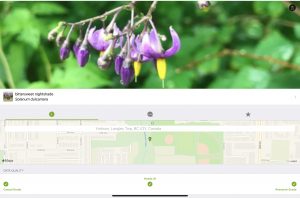
We still did not know which First Nations People lived/live near the creek so we used the website https://www.bcafn.ca/first-nations-bc/interactive-map and with a click found out it was the Kwantlen First Nation. From there we were able to click on a link and were directed to a page with loads of useful information that was highly visual and easy for kids or anyone to navigate.
So How Was This Activity Inquiry-Based learning…….
My son already knows a lot about nature. He used a lot of the information he already knows and asked questions to build upon that. As, Barbara Stripling suggests in her Using Inquiry… (2004) article, Inquiry is quite simply:… a way of learning that requires active engagement. If this is a simple way of defining inquiry then we were doing it. My son was so excited he was running around everywhere with the iPAD totally engaged and asking a zillion questions. He was equally excited when he found the answers to his questions. Often his answers would lead to more questions which I know is a wonderful sign.
I would say that the type of inquiry we were practicing was guided. I picked the topic (nature close to home) and selected the resources to help find our answers. I showed my son how to use the technology and previewed the books, including the glossary and indexes. Then I gave him free rein to choose which creatures/plants to ask questions about. According to MacKenzie (2016) , this type of inquiry would be considered “controlled inquiry”. I think this type of inquiry works best for young students or any students needing extra support. I can see how students would be able to practice this type of inquiry and eventually with practice and time could move into more independent types with less teacher involvement.
How could the school library learning commons be inserted into this kind of activity?
I really throughly enjoyed this activity and feel like the possibilities with it are endless. The whole school could collaborate on the app and even include the community to help identify plants and animals in and around the school and community. The app has an interactive map where you can tag where the plants and animals are found. There is also another section where you can collaborate on group projects. One idea I had, is the school could make a plant walk and identify plants, their names, uses and indigenous history. The older kids could work together with younger ones. They could even make QR code’s so that visitors could use their iPhones to easily access information and even add to it. This app is highly interactive and collaborative in nature. Once a bunch of plants and animals are identified students could then pick one and do their own research on it. The app even has a teacher guide with loads of more tips, tricks and ideas https://inaturalist.ca/pages/teacher%27s+guide
Three personal learning objectives that I have for this course…..
- I want to become more confident in my ability to lead kids of all ages in inquiry. I feel like kids know if a teacher is unsure of something. If they see that I am confident and know what I am doing they will be more confident too. I think that this will also come with time and lots of practice. But also from learning from others.
- I want to better understand how to develop “essential questions’ . This sounds straight forward but i think it is almost an art form. Building an essential question is so important because it sets the basis for the inquiry. Again, I think time and practice will help as well as learning with and from others in my class here and my school.
- Last, I want to be able to use my time wisely. Whenever I have used inquiry in the past I have never allowed enough time for kids to reflect throughly enough. I understand that this is a crucial part of the process. I want to understand how I can do this so that my kids get the most out of their inquiry as possible.
I am very excited for this class and to start my immersion into inquiry!
References:
- Cohen, F., & Fylling, M. (2017). Curious kids nature guide: Explore the amazing outdoors of the Pacific Northwest. Seattle, WA: Little Bigfoot, an imprint of Sasquatch Books.
- INaturalist, L. (2011, February 24). iNaturalist. Retrieved September 8, 2021, from https://apps.apple.com/us/app/inaturalist/id421397028
- First Nations in BC. (n.d.). Retrieved September 12, 2021, from https://www.bcafn.ca/first-nations-bc/interactive-map
- Pojar, J., MacKinnon, A., & Alaback, P. B. (2017). Plants of coastal British Columbia: Including Washington, Oregon & Alaska. Vancouver, B.C.: Langara College.
- Medicinal Herbsnatural medicineherbs information. (n.d.). Retrieved September 12, 2021, from http://naturalmedicinalherbs.net/
- MacKenzie, T. (2019). Dive into inquiry: Amplify learning and empower student voice. Victoria, BC, Canada?: ElevateBooksEdu.
- Stripling, B. K. (2008). Inquiry: Inquiring minds want to know. School Library Media Activities Monthly 25(1): 50-52.


